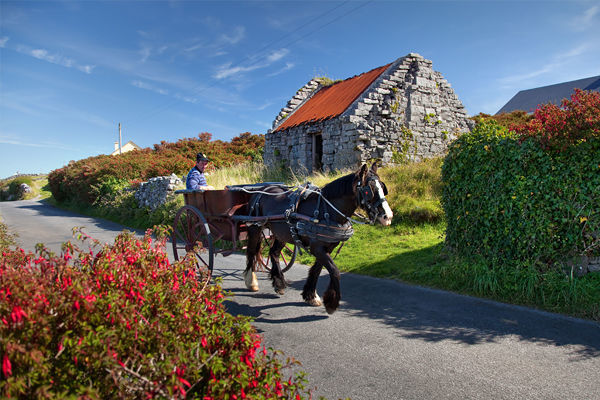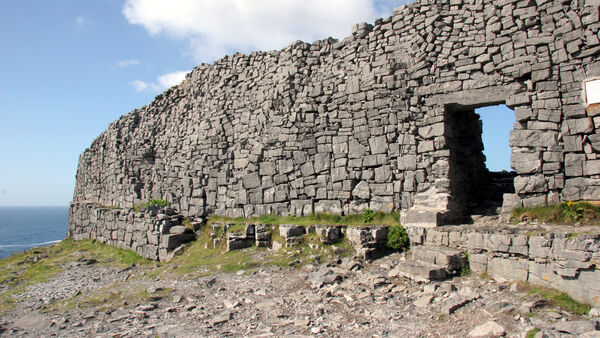Ireland’s Aran Islands: Bleak and Beautiful
Amid the Aran Islands' starkly beautiful windswept landscape are dramatic cliffs and bits of mysterious history.
By Rick Steves

Not long ago, I spent a day walking on Inishmore, one of the weather- and wave-beaten Aran Islands — which, on a blustery day, seem to gulp seawater off the west coast of Ireland. An elfish, black-clad farmer, determined to make the most of a break in the clouds, invites me to help him turn his hay. Drying in the breeze, it's destined to become a hearty salad for his cows.
The Aran Islands are a short flight or 40-minute ferry ride from the Rossaveel ferry port near Galway, the main town on Ireland's west coast. Three limestone islands make up the Aran Islands: Inishmore, Inishmaan, and Inisheer. The "largest" is Inishmore — nine miles of land with one sleepy town, a few farming hamlets, and a weather-beaten charm.
The other islands, Inishmaan and Inisheer, are even smaller, much less populated, and less touristy. For most, the big island is quiet enough. Inishmore — and the Aran Islands as a whole — has only one real town, Kilronan. It's actually more like a village, with groups of backpackers washing ashore with the landing of each ferry.
The islands are still part of the Gaeltacht, where locals speak the Irish Gaelic language among themselves — but they happily speak English for their visitors. There are fewer than 100 vehicles on Inishmore, and about a third are in the business of showing day-trippers the sights. A line of minibuses awaits the arrival of each ferry, offering convenient island tours with stops at all the major sights for about €20. Bike-rental shops and a few men in horse carts sop up the remaining tourists, who often return from tours to browse through the few shops and enjoy a pint of Guinness on a picnic table outside a pub.
The windswept landscape of all three islands is harsh and stony, separated from the sea by steep, rugged cliffs. But there's a stark beauty about these blustery islands and the simple lives its inhabitants eke out of a few inches of topsoil and a mean sea.
Like the rest of Ireland, Inishmore has a mysterious history. The island's famous Iron Age fortress, Dun Aengus, is the most impressive of its kind in all of Europe. Little is known about this 2,000-year-old Celtic fort. This stone fortress hangs spectacularly and precariously on the edge of a cliff 300 feet above the Atlantic. And there's no fence at all — only a sheer drop-off. For 20 centuries angry waves have battered away at its black foundation. (A minibus driver once told me that the fort was so popular with visitors that "we plan to build another 2,000-year-old ring fort next year.") While the next parish over may indeed be Boston, the crashing waves below seem to declare, "This is the end of the world."
Close to the western tip of the island is the "Seven Churches," a historic but visually unimpressive gathering of ruined chapels, monastic houses, and fragments of a high cross dating from the 8th to the 11th centuries. Here, as throughout Inishmore, the land is dotted with reminders of the island's early Christianity. Some honor St. Enda, who established a monastery here and taught great monks who followed in his footsteps. These "Irish apostles" started Ireland's "Age of Saints and Scholars" (AD 500–900) — an Irish golden age of learning, literature, and flourishing religious arts. It was during this time that stonemasons created the distinctive and stylistic crosses so iconic of early Ireland, and leaders such as Charlemagne on the nearly illiterate continent of Europe imported Irish monks to be their scribes.
The stones of Inishmore tell this community's story. This tiny island, which looks like alligator skin from the air, is a maze of stone fences. Poor people cleared the stony land to make it arable. Turning my farmer friend's hay, I ponder how, with unrivaled colonial finesse, the British required Irish families to divide their land among all their sons. This doomed even the largest estates to fragmentation, shrinking lots to sizes just large enough to starve a family. Ultimately, of course, the land ended up in the possession of British absentee landlords. The tiny rock-fenced lots that carve up the treeless landscape still remind the farmers of the structural poverty that shaped their history.

